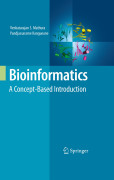
Bioinformatics is an evolving field that is gaining popularity due to genomics, proteomics and other high-throughput biological methods. The function of bioinformatic scientists includes biological data storage, retrieval and in silico analysis of the results from large-scale experiments. This requires a graspof knowledge mining algorithms, a thorough understanding of biological knowledge base, and the logical relationship of entities that describe a process or the system. Bioinformatics researchers are required to be trained in multidisciplinary fields of biology, mathematics and computer science. Currently the requirements are satisfied by ad hoc researchers who have specific skills in biology or mathematics/computer science. But the learning curve is steep and the time required to communicate using domain specific terms is becoming a major bottle neck in scientific productivity. This workbook provides hands-on experience which has been lacking for qualified bioinformatics researchers. Textbooksprovide a practical introduction to bioinformatics and computer technologies Workbook which spends more time showing students techniques and applications, problems and solutions Less theoretical, more practical and applied, and can be used as a companion to a more comprehensive text INDICE: Foreword.- Introduction to Living Systems and Its Components.- Fundamentals of Programming Concepts.- Introduction to Statistics and Probability.- Biological Databases.- Sequence Analysis.- Protein Structure Prediction andModelling.- Macromolecular Visualization.- Comparative Genomics.- DNA Chips/Array.- Proteomics.- Drug Discovery.- Computational Immunology.- Bioinformaticsand Industrial Application.- Bioinformatics Web Tools.- Case Study/Comprehensive Biological Project.- List of Useful Resources.
- ISBN: 978-0-387-84869-3
- Editorial: Springer
- Encuadernacion: Cartoné
- Páginas: 205
- Fecha Publicación: 01/11/2008
- Nº Volúmenes: 1
- Idioma: Inglés
